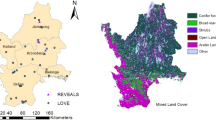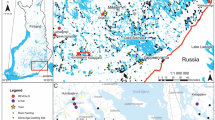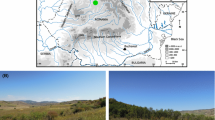Abstract
Long-term records of environmental history at decadal to millennial time-scales enable an assessment of ecosystem variability and responses to past anthropogenic disturbances and are fundamental for the development of environmental management strategies. This study examines the local variability of land-use history in the South Swedish Uplands over the last 200 years based on pollen records from three lake-sediment successions. Temporal changes in the proportional cover of 14 plant taxa were quantified as percentages using the landscape reconstruction algorithm (LRA). The LRA-based estimates of the extent of four land-use categories (cropland, meadows/grassland, wetland, outland/woodland) were compared to corresponding estimates based on historical maps and aerial photographs from ad 1769–1823, 1837–1895, 1946 and 2005. Although the LRA approach tends to overestimate grassland cover by 10–30 % for the two earliest time periods, the reconstructed vegetation composition is generally in good agreement with estimates based on the historical records. Subsequently, the LRA approach was used to reconstruct the 200-year history of local land-use dynamics at 20-year intervals around two small lakes. The qualitative assessment of difference approach, which requires fewer assumptions and parameters than LRA for objective evaluation of between-site differences in plant abundances, provides consistent results in general. Significant differences exist in the land-use history between the sites. Local catchment characteristics, such as soil conditions and wetland cover, appear important for the development of human impact on the landscape. Quantifications of past vegetation dynamics provide information on the amplitude, frequency and duration of the land-use changes and their effects on terrestrial and aquatic ecosystems, and should be taken into account when nature conservation strategies are developed.








Similar content being viewed by others
References
Alexandersson H, Karlström C, Larsson-McCann S (1991) Temperature and precipitation in Sweden, 1961–1990, Reference normals. SMHI report 81. Norrköping
Anderson J, Bugmann H, Dearing JA, Gaillard M-J (2006) Linking palaeoenvironmental data and models to understand the past and to predict the future. Trends Ecol Evol 21:696–704
Andersson Palm L. (2000) Folkmängden i Sveriges socknar och kommuner 1571–1997, Göteborg
Berglund BE (1991) The cultural landscape during 6,000 years in southern Sweden—the Ystad Project. Ecological Bulletins 41. Munksgaard International Booksellers and Publishers, Copenhagen
Berglund BE, Ralska-Jasiewiczowa M (1986) Pollen analysis and pollen diagrams. In: Berglund BE (ed) Handbook of Holocene palaeoecology and palaeohydrology. Wiley, Chichester, pp 155–484
Beug H-J (2004) Leitfaden der Pollenbestimmung für Mitteleuropa und angrenzende Gebiete. Pfeil, München
Boyle JF (2000) Rapid elemental analysis of sediment samples by isotope source XRF. J Paleolimnol 23:213–221
Bragée P, Choudhary P, Routh J, Boyle JF, Hammarlund D (2013a) Lake ecosystem responses to catchment disturbance and airborne pollution: an 800-year perspective in southern Sweden. J Paleolimnol 50:545–560
Bragée P, Mazier F, Rosén P, Fredh D, Broström A, Granéli W, Hammarlund D (2013b) Forcing mechanisms behind variations in total organic carbon (TOC) concentration of lake waters during the past 8th centuries—palaeolimnological evidence from southern Sweden. Biogeosci Discus 10:19,969–20,003
Broström A, Sugita S, Gaillard M-J (2004) Pollen productivity estimates for the reconstruction of past vegetation cover in the cultural landscape of southern Sweden. Holocene 14:368–381
Broström A, Nielsen AB, Gaillard M-J et al (2008) Pollen productivity estimates of key European plant taxa for quantitative reconstruction of past vegetation—a review. Veget Hist Archaeobot 17:461–478
Bunting MJ, Gaillard M-J, Sugita S, Middleton R, Broström A (2004) Vegetation structure and pollen source area. Holocene 14:651–660
Cousins SAO (2001) Analysis of land-cover transitions based on 17th and 18th century cadastral maps and aerial photographs. Landscape Ecol 16:41–54
Cui Q (2013) Fire history in the hemiboreal and southern boreal zones of southern Sweden during 11000 years—Relationships with past vegetation composition and human activities and implications of biodiversity issues, Dissertation, Linnaeus University, Kalmar
Cui Q, Gaillard M-J, Lemdahl G, Stenberg L, Sugita S, Zernova G (2014) Historical land-use and landscape change in southern Sweden and implications for present and future biodiversity. Ecol Evol 4:3,555–3,570
Dahlström A (2008) Grazing dynamics at different spatial and temporal scales: examples from the Swedish historical record ad 1620–1850. Veget Hist Archaeobot 17:563–572
Daniel E (2009) Beskrivning till jordartskartan 5E Växjö NV. Sveriges geologiska undersökning K 168
Eisenhut G (1961) Untersuchungen über die Morphologie und Ökologie der Pollenkörner heimischer und fremdländischer Waldbaüme. Parey, Hamburg
Ekstam U, Forshed N (1992) Om hävden upphör. Kärlväxter som indikatorarter i ängs- och hagmarker, Naturvårdsverket, Solna
Eliasson P (2002) Skog, makt och människor. En miljöhistoria om svensk skog 1800–1875. Dissertation, Lund University, Lund
Emanuelsson U (2009) The rural landscapes of Europe—How man has shaped European nature. Forskningsrådet Formas, Stockholm
Fredh D (2012) The impact of past land-use change on floristic diversity in southern Sweden—a quantitative approach based on high-resolution pollen data. Dissertation, Lund University, Lund
Fredh D, Broström A, Zillén L, Mazier F, Rundgren M, Lagerås P (2012) Floristic diversity in the transition from traditional to modern land-use in southern Sweden ad 1800–2008. Veget Hist Archaeobot 21:439–452
Fredh D, Broström A, Rundgren M, Lagerås P, Mazier F, Zillén L (2013) The impact of land-use change on floristic diversity at regional scale in southern Sweden 600 bc–ad 2008. Biogeosciences 10:3,159–3,173
Gadd CJ (2000) Den agrara revolutionen 1700–1870. Natur och Kultur/LTs förlag, Stockholm
Gregory PH (1973) The microbiology of the atmosphere. A Plant science monograph. Leornard Hill, Aylesbury
Grimm EC (1987) CONISS: a FORTRAN 77 program for stratigraphically constrained cluster analysis by the method of incremental sum of squares. Comput Geosci 13:13–35
Gustafsson L, Ahlén I (1996) National Atlas of Sweden—geography of plants and animals. SNA publishing, Stockholm
Hellman S, Gaillard M-J, Broström A, Sugita S (2008a) Effects of the sampling design and selection of parameter values on pollen-based quantitative reconstructions of regional vegetation: a case study in southern Sweden using the REVEALS model. Veget Hist Archaeobot 17:445–459
Hellman S, Gaillard M-J, Broström A, Sugita S (2008b) The REVEALS model, a new tool to estimate past regional plant abundance from pollen data in large lakes—validation in southern Sweden. J Quat Sci 23:21–42
Hellman S, Bunting MJ, Gaillard MJ (2009a) Relevant source area of pollen in patchy cultural landscapes and signals of anthropogenic landscape disturbance in the pollen record: a simulation approach. Rev Palaeobot Palynol 153:245–258
Hellman S, Gaillard M-J, Bunting JM, Mazier F (2009b) Estimating the relevant source area of pollen in the past cultural landscapes of southern Sweden—a forward modelling approach. Rev Palaeobot Palynol 153:259–271
Hjelle K, Sugita S (2012) Estimating pollen productivity and relevant source area of pollen using lake sediments in Norway: how does lake size variation affect the estimates? Holocene 22:313–324
Ihse M, Norderhaug A (1995) Biological values of the Nordic cultural landscape: different perspectives. Int J Herit Stud 1:156–170
Johansson LJ, Hall K, Prentice HC, Ihse M, Reitalu T, Sykes MT, Kindström M (2008) Semi-natural grassland continuity, long-term land-use change and plant species richness in an agricultural landscape on Öland, Sweden Landscape. Urban Plan 84:200–211
Matthias I, Nielsen A, Giesecke T (2012) Evaluating the effect of flowering age and forest structure on pollen productivity estimates. Veget Hist Archaeobot 21:471–484
Mazier F (2006) Modélisation de la relation entre pluie pollinique actuelle, végétation et pratiques pastorales en moyenne montagne (Pyrenees et Jura). Application pour l’interprétation des données polliniques fossiles. Dissertation, Université de Franche-Comté/Université de Neuchâtel
Mazier F, Gaillard MJ, Kuneš P, Sugita S, Trondman AK, Broström A (2012) Testing the effect of site selection and parameter setting on REVEALS-model estimates of plant abundance using the Czech Quaternary Palynological Database. Rev Palaeobot Palynol 187:38–49
Morell M (2001) Jordbruket i industrisamhället 1870–1945. Natur och Kultur/LTs förlag, Stockholm
Myrdal J (1997) En agrarhistorisk syntes. In: Larsson BMP, Morell M, Myrdal J (eds) Agrarhistoria. LTs Förlag, Stockholm
Nielsen AB (2004) Modelling pollen sedimentation in Danish lakes at C. ad 1800: an attempt to validate the POLLSCAPE model. J Biogeogr 31:1,693–1,709
Nielsen AB, Odgaard B (2010) Quantitative landscape dynamics in Denmark through the last three millennia based on the landscape reconstruction algorithm approach. Veget Hist Archaeobot 19:375–387
Nielsen AB, Sugita S (2005) Estimating relevant source area of pollen for small Danish lakes around ad 1800. Holocene 15:1,006–1,020
Nielsen AB, Giesecke T, Theuerkauf M et al (2012) Quantitative reconstructions of changes in regional openness in north-central Europe reveal new insights into old questions. Quat Sci Rev 47:131–149
Örback AIE (1998) Lantmäterikartorna som historisk källa. In: Sporrong U, Wennström H-F (eds) Sveriges Kartor: Sveriges Nationalatlas. Lantmäteriverket, Stockholm
Overballe-Petersen MV, Nielsen AB, Bradshaw RHW (2012) Quantitative vegetation reconstruction from pollen analysis and historical inventory data around a Danish small forest hollow. J Veg Sci 24(4):755–771
Prentice IC (1985) Pollen representation, source area, and basin size: toward a unified theory of pollen analysis. Quat Res 23:76–86
Prentice IC (1988) Records of vegetation in time and space: the principles of pollen analysis. In: Huntley B, Webb T (eds) Vegetation history. Kluwer, Dordrecht, pp 17–42
Punt W, Blackmore S, Clarke GSC, Hoen PP (1976–2009) The Northwest European Pollen Flora (NEPF) Vol I (1976), Vol II (1980), Vol III (1981), Vol IV (1984) Vol V (1988), Vol VI (1991), Vol VII (1996), Vol VIII (2003), Vol IX (2009). Elsevier, Amsterdam
Renberg I, Hansson H (2008) The HTH sediment corer. J Paleolimnol 40:655–659
Renberg I, Bigler C, Richard B, Matilda N, Rydberg J, Segerström U (2009) Environmental history: a piece in the puzzle for establishing plans for environmental management. J Environ Manag 90:2,794–2,800
Sjörs H (1963) Amphi-atlantic zonation, nemoral to arctic. In: Löve A, Löve D (eds) North Atlantic biota and their history. Pergamon Press, Oxford, pp 109–125
Skånes HM, Bunce RGH (1997) Directions of landscape change (1741–1993) in Virestad, Sweden—characterised by multivariate analysis. Landscape Urban Plan 38:61–75
Soepboer W, Sugita S, Lotter AF (2010) Regional vegetation-cover changes on the Swiss Plateau during the past two millennia: a pollen-based reconstruction using the REVEALS model. Quat Sci Rev 29:472–483
Stuart A, Ord JK (1994) Kendall’s advanced theory of statistics. Distribution theory, Vol 1 Edward Arnold, London
Sugita S (1993) A model of pollen source area for an entire lake surface. Quat Res 39:239–244
Sugita S (1994) Pollen representation of vegetation in quaternary sediments: theory and method in patchy vegetation. J Ecol 82:881–897
Sugita S (2007a) Theory of quantitative reconstruction of vegetation. I: pollen from large lakes REVEALS regional vegetation composition. Holocene 17:229–241
Sugita S (2007b) Theory of quantitative reconstruction of vegetation. II: all you need is LOVE. Holocene 17:243–257
Sugita S, Gaillard M-J, Broström A (1999) Landscape openness and pollen records: a simulation approach. Holocene 9:409–421
Sugita S, Parshall T, Calcote R (2006) Detecting differences in vegetation among paired sites using pollen records. Holocene 16:1,123–1,135
Sugita S, Gaillard M-J, Hellman S, Broström A (2008) Model-based reconstruction of vegetation and landscape using fossil pollen. In: Posluschny A, Lambers K, Herzog I (eds) Layers of Perception, Proceedings of the 35th International Conference on Computer Applications and Quantitative Methods in Archaeology (Kolloquien zur Vor- und Frühgeschichte 10). Habelt, Bonn, pp 385–391
Sugita S, Parshall T, Calcote R, Walker K (2010) Testing the landscape reconstruction algorithm for spatially explicit reconstruction of vegetation in northern Michigan and Wisconsin. Quat Res 74:289–300
Sundbärg (1883) Dödligheten månads- och årstidsvis i Sverige, 1861–1880 (Monthly and seasonal variation in mortality in Sweden, 1861–80) (in Swedish). Statistisk Tidskrift 69:153–194
Thompson R, Bloemendal J, Dearing JA, Oldfield F, Rummery TA, Stober JC, Turner GM (1980) Environmental applications of magnetic measurements. Science 207:481–486
Wikman H (2000) Beskrivning till berggrundskartorna 5E Växjö NO och NV. Sveriges geologiska under-sökning Af 201 & 216
Willis KJ, Birks HJB (2006) What is Natural? The need for a long-term perspective in biodiversity conservation. Science 314:1,261–1,265
Acknowledgments
We are very thankful to all members of the NordForsk network LANDCLIM (coordinated by M.J. Gaillard, Linnaeus University, Sweden) for useful and inspiring discussions during the numerous network workshops (2009–2011). This work was funded by the Swedish Research Council Formas through Grants 2006–547 to W. Granéli and 2007-1012 to A. Broström. S.S. was supported by the funding available through the Estonian Mobilitas Programme (MTT3), and F.M. by the French project ANR 2010 JCJC 1804 01 ≪MODE RESPYR≫ (http://www.w3.mode-respyr.univtlse2.fr/index.php). We are also grateful to Sheila Hicks for careful checking and editing the text and to three reviewers (Thomas Giesecke and two anonymous) for valuable suggestions for revisions and corrections of an earlier version of the manuscript.
Author information
Authors and Affiliations
Corresponding author
Additional information
Communicated by F. Bittmann.
Electronic supplementary material
Below is the link to the electronic supplementary material.
Rights and permissions
About this article
Cite this article
Mazier, F., Broström, A., Bragée, P. et al. Two hundred years of land-use change in the South Swedish Uplands: comparison of historical map-based estimates with a pollen-based reconstruction using the landscape reconstruction algorithm. Veget Hist Archaeobot 24, 555–570 (2015). https://doi.org/10.1007/s00334-015-0516-0
Received:
Accepted:
Published:
Issue Date:
DOI: https://doi.org/10.1007/s00334-015-0516-0




